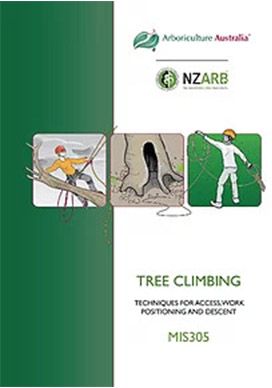
MIS305 Tree Climbing
MIS305 Tree Climbing - 2nd ed.
Minimum Industry Standard series Members Price is for Members of The New Zealand Arboricultural Association (NZARB). The vision of NZ Arb is to represent the arboriculture community and make it the primary organisation for tree care and to maintain relevancy to the Association’s members, so if you are in the NZ tree care industry please consider joining NZARB by clicking the link above if you are not already a member. |
This book is one in a series of Minimum Industry Standards produced by Arboriculture Australia Ltd and the New Zealand Arboricultural Association in consultation with the national arboriculture community in both countries. These industry peer-reviewed documents provide a ‘body of knowledge’ which is shared by practitioners and can be used as the basis for training, dissemination of skills and professional development.
This book covers the basics of tree climbing equipment and tree access using a variety of tree climbing skills and techniques. Many other techniques, climbing systems and climbing equipment configurations are possible which are not discussed in this document. Nevertheless, the skills and techniques presented in this document form a solid foundation on which practitioners can build.
Contents:
INTRODUCTION TO TREE CLIMBING
TREE CLIMBING EQUIPMENT ESSENTIAL TREE CLIMBING EQUIPMENT
EQUIPMENT INSPECTION
CLIMBING SYSTEMS
CLIMBING SYSTEM COMPARISON
CORRECT SELECTION AND USE OF TREE CLIMBING EQUIPMENT
PREPARING TO WORK IN TREES SITE AND TREE HAZARD INSPECTION
PREPARING FOR CLIMBING
CLIMB PLANS
COMMUNICATION TREE CLIMBING: CORE SKILLS CORE SKILLS 1: INSTALLING AN ANCHOR POINT
CORE SKILLS 2: WORK POSITIONING
| CLIMBING TECHNIQUE 1: MOVING ROPE TECHNIQUE
MRT TIE-IN-POINTS: FRICTION SAVERS
DESCENDING FROM A TREE CLIMBING TECHNIQUE 2: SPUR CLIMBING SPUR FIT, SHARPENING AND ADJUSTMENT
SPUR CLIMBING - BASIC TECHNIQUE
WORKING ON CLIMBING SPURS
CLIMBING TECHNIQUE 3: STATIONARY ROPE TECHNIQUE INTRODUCTION TO STATIONARY ROPE TECHNIQUE
BASICS OF SRT CLIMBING - SRT SYSTEMS
TECHNIQUES FOR SRT WORK POSITIONING
ADDITIONAL SKILLS 1: REDIRECTS REDIRECT TERMINOLOGY REDIRECTS, ROPE ANGLE AND FORCES
ADDITIONAL SKILLS 2: USE OF MULTIPLE LINES ACCESS LINES USE OF MULTIPLE LINES
FLOATING ANCHORS AND HIGH LINES APPENDIX A: HAZARD CONTROL MEASURES BRACING AN ANCHOR POINT GUYING A TREE STRAPPING OR CINCHING A CRACK OR SPLIT IN A TREE |
Minimum Industry Standards
The Minimum Industry Standard series is dedicated to all our fellow workers who have lost their lives or have been permanently injured working in the arboriculture and vegetation management industries.
The Minimum Industry Standards project is an Arboriculture Australia led initiative that the NZ Arb is pleased and proud to be involved with. Having joined the programme, NZ Arb works alongside Arboriculture Australia to develop these Minimum Industry Standards. Each Minimum Industry Standard (MIS) provides the key knowledge that is necessary to perform the work task.
| Dimensions | 150 x 210 mm |
| Pages | 184 |
| Cover | Soft Cover |
| Binding | Wire-O |
